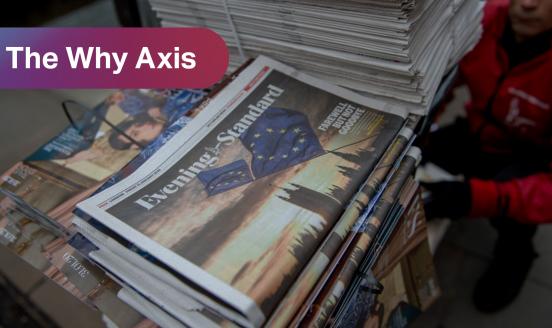Super Mario: 1up?
The stake at this month’s meeting of the ECB’s Governing Council was exceptionally high. Mario Draghi himself raised the bar of expectations, with his
The stake at this month’s meeting of the ECB’s Governing Council was exceptionally high. Mario Draghi himself raised the bar of expectations, with his intervention at Jackson Hole. That speech marked a significant change in his language, on a number of important dimensions. The risk that the Governing Council would not endorse this shift was not to be underestimated ex ante, with all the implications of betraying expectations at their height. Eventually, Super-Mario delivered.
Language and assessment
A first important point in Draghi’s press conference is the confirmation of a major change in the ECB’s language over both inflation and the economic outlook.
Concerning inflation, at the press conference in August the official line was still that “inflation expectations for the euro area over the medium to long term continue to be firmly anchored in line with our aim of maintaining inflation rates below, but close to, 2%.” At Jackson Hole, Draghi’s language was markedly different. He explicitly acknowledged the growing risks that inflation expectations could dis-anchor: “financial markets have indicated that inflation expectations exhibited significant declines at all horizons. (…) if we go to shorter and medium-term horizons the revisions have been even more significant.”
At yesterday’s press conference, the shift in confidence became part of the official language. The ECB president said that the inflation outlook worsened in August and that during the month the ECB had seen “downward movement in all indicators of inflation expectations, across all maturities”. The 5y/5y swap rate – ECB’s preferred measure for inflation expectations - backed up after the Jackson Hole speech but other measures did not, scaring the Governing Council.
Importantly, the usual reference to “firmly anchored inflation expectations” completely disappeared from the introductory remarks. Draghi only touched upon the issue when explicitly asked, in a question, whether inflation expectations can still be defined as well anchored. He said they still are, but that the downward risk is increasing (to a point that obviously calls for ECB action).
Another interesting point Draghi made – again in the Q&A – was about the drivers of (dis)-inflation surprises. He said that while in the past forecast errors on inflation could largely be explained by errors in forecasting the food/energy components, recently the link with factors that are “not exogenous to the Eurozone economy”, such as the degree of slack, has been growing.
And the language was also markedly different in the qualification of the economic outlook. The previous Governing Council meeting referred to a “continued moderate and uneven recovery of the euro area economy, with low rates of inflation and subdued monetary and credit dynamics.” In Jackson Hole, Draghi went further, saying “the recovery in the euro area remains uniformly weak, with subdued wage growth even in non-stressed countries suggesting lackluster demand.” Yesterday, any optimism about the economic cycle seemed to be gone, as the ECB president said that “the recovery is likely to continue to be dampened by high unemployment, sizeable unutilised capacity, continued negative MFI loan growth to the private sector, and the necessary balance sheet adjustments in the public and private sectors”. The ECB staff’s macroeconomic projections for economic activity do indeed depict a bleaker outlook, with annual real GDP expected to increase by only 0.9% in 2014, 1.6% in 2015 and 1.9% in 2016, implying a downward revision of projections both 2014 and 2015.
Rate cut
At yesterday’s meeting, the Governing Council lowered all the rates in the corridor. The rate on main refinancing operations was lowered by 10 basis points to 0.05%, starting from the operation to be settled next week. The interest rate on the marginal lending facility will be decreased by 10 basis points to 0.30% whereas the interest rate on the deposit facility will be decreased by 10 basis points to -0.20%, again with effect from 10 September 2014.
Only 4 out of 47 economists polled by the Wall Street Journal were expecting the ECB to move on rates. Part of the reason why the rate cut was largely unanticipated is related to a previous statement at theJune monthly press conference – when the MRO rate was cut to 0.15% - Draghi has said in fact that “for all practical purposes” the ECB had “reached the lower bound”. However, he had also added that this did not “exclude some little technical adjustment” which could “lead to some lower interest rates in one or the other or both parts of the corridor”. The ambiguity was enough for the cut to be unanticipated and have a strong impact, with the euro/dollar reaching the lowest since July 2013 on announcement.
In the Q&A Draghi clarified that the rate cut is intended to make sure that no doubt remains about the fact that the ECB has now reached the lower bound, where these “technical adjustments” are no longer possible. Importantly, this decision also serves as a signal to the banks, in view of the approaching TLTRO operations. With the MRO at 0.05%, the terms of the TLTRO imply that the operation will be conducted at a rate of 0.15% (MO rate + 10 bp). Draghi explicitly said in the Q&A that the rate cut removes any incentive that banks participating in the TLTRO could possibly still have to hesitate in expectation of lower rates, because the rates will not be lower than this. Although several issues remain about the effectiveness of the TLTRO (see here and here, for previous discussions) this measure is a message to banks that the ECB expects them not to be shy in the take up.
Asset purchases
In addition, the Governing Council decided to start purchasing non-financial private sector assets, as recommended in our paper on the ECB's shopping list to fight weak inflation. The Eurosystem will purchase a “broad portfolio of simple and transparent asset-backed securities (ABSs) with underlying assets consisting of claims against the euro area non-financial private sector under an ABS purchase programme (ABSPP)”. In parallel, the Eurosystem will also run a third wave of purchases of covered bonds issued by MFIs domiciled in the euro area (CBPP3).
Interventions under these programmes will start in October 2014 and the detailed modalities of these programmes will be announced after the Governing Council meeting of 2 October 2014. The announcement and the discussion in Q&A raise further important points.
- Size: perhaps the most awaited piece of information – the size of the programme – is still missing. Draghi said that the complexity of the operation does not allow the ECB to name a figure at the moment (although it could be argued that the ECB did name a figure on announcements of previous covered bonds purchase programmes). It is not clear whether size will be part of the announcement due on the 2nd of October, but it should be, as ambiguity and opacity could reduce the effect on expectation.
Draghi indirectly dropped a possible hint, however. He said that the aim of the package adopted is twofold: on one hand, broaden the measures that go in the direction of easing credit; on the other hand, significantly stir the size of the ECB’s balance sheet towards the size it had in 2012. As I highlighted in a previous analysis, a “special” feature in the development of the ECB’s balance sheet over the last year is that fact that the shrinkage is outside the control of the ECB, as the main driver is precisely banks’ decision to reimburse funds they borrowed from the ECB itself.
- Composition: Draghi reiterated that the target will be “simple and transparent” product and stressed that the ECB wants to make sure “these ABS are used to extend credit to real economy“. ABS are the key to unlocking Europe’s credit market. Obviously one key missing point is the exact definition of “simple” and “transparent”, but the Draghi said that the ECB has experience in valuation and pricing of ABS due to the inclusion of these securities in the collateral framework, so this might suggest the target pool be limited to what is already eligible as collateral for the lending operations. Importantly, Draghi clarified that ABS purchase will include RMBS – which could be indeed necessary to achieve a meaningful firepower. This was not obvious in June, and it may seem contradictory with the fact that the TLTRO instead does not include mortgages.
Concerning covered bonds programme - the only previous examples of ECB unsterilised asset purchases – the assessment of the two previous programmes by the ECB was positive. Bank bonds are indeed the second largest asset class of assets that the ECB could purchase (after government bonds, which seem to be ruled out of the picture). However, as previously noted here, buying bank bonds before the completion of the Comprehensive Assessment (and its follow up) could put the ECB in an uncomfortable position and raise issue of conflicts of interest.
- Unanimity: Mario Draghi said that the decision was not unanimous, although based on what he defined as a “comfortable majority”. He explicitly said that some Governors wanted to do more and some less. This raise again the important issue of transparency on the ECB’s. The issue of publishing the minutes of the ECB’s meeting – as done by FED and BoE – was raised in a recent past but it is unclear when this will happen. This Governing Council meeting shows probably better than anything else why this would be needed and helpful.
The Structural reform compact
The central bank can ease credit a lot, but if those who ask for credit then have to wait months or years before they can open their business, easy credit does not help. This is perhaps the clearest example that Draghi could have chosen to explain his view on structural reforms, which have been increasingly featured in his public speeches.
Yesterday, he repeated his stance of Jackson Hole. The basic idea in that speech was that three instruments can be helpful in revamping growth: fiscal policy, monetary policy and structural reforms. But Draghi is more and more explicit about the fact that no fiscal or monetary stimulus can do the job without “ambitious, important and string structural reforms”. This is why the ECB president said structural reform effort needs to gain momentum, and while these reforms can be costly, low growth is also a major cost.
Importantly, he re-stated his call for a discussion about the aggregate Eurozone fiscal stance, a major change of mind from the institution that was on the forefront for advocating the fiscal compact in 2011. But the language about the “flexibility discussion” surrounding the application of fiscal rules was equally crystal clear. “The SGP is our anchor of confidence” – he said, and confidence is highly needed because in the Eurozone there are different reasons why growth not coming back, but one of these is lack of confidence. Then, “from a confidence strengthening viewpoint it would be much better if we were to have first a very serious discussion on structural reforms and then a discussion of flexibility”. Draghi’s preferred sequencing is therefore clearly stated, as his the fact that the ECB does not intend and cannot do national governments’ job.
Concerning the structural reforms, it’s also clear that the preferred solution of the ECB would be one at the European level, underpinned by a rigorous application of the macroeconomic imbalance procedure. Draghi’s language was remarkably sharp on this point: country should not consider this a loss of sovereignty, but a sharing of it, as for monetary policy. Draghi said that previously to euro, all central banks (perhaps with the exception of one) had actually lost sovereignty. “The Euro created the possibility to share it.” Implicitly, the message seems to be that sharing sovereignty on structural reforms would not be very different.
This was probably the most important move of the ECB since the announcement of the OMT, in September 2012. At stake was the credibility of Mario Draghi and the ability to push his Jackson Hole position through the Governing Council. The risk of betraying the exceptionally high expectations that he had created was not to be underestimated, but Mario Draghi eventually delivered, even though the actual size of the programme needs to be clarified. In poker-like twist, he also made clear that it’s now the turn of European policymakers to meet his expectations.



